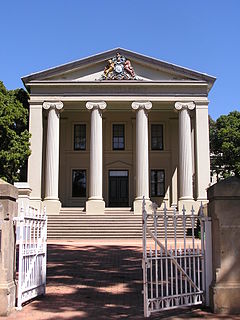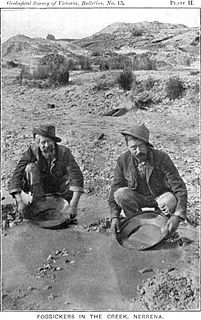
The Victorian gold rush was a period in the history of Victoria, Australia approximately between 1851 and the late 1860s. It led to a period of extreme prosperity for the Australian colony, and an influx of population growth and financial capital for Melbourne, which was dubbed "Marvellous Melbourne" as a result of the procurement of wealth.

The Eureka Flag is a flag design which features dark blue field 260 cm × 400 cm ; a horizontal stripe 37 cm (15 in) wide and a vertical line crossing it of 36 centimetres (14 in) wide; and 5 eight pointed stars, the central star being 65 cm (26 in) tall and the other stars 60 cm (24 in) tall, representing the Crux Australis constellation.

The Otago Gold Rush was a gold rush that occurred during the 1860s in Central Otago, New Zealand. This was the country's biggest gold strike, and led to a rapid influx of foreign miners to the area - many of them veterans of other hunts for the precious metal in California and Victoria, Australia.
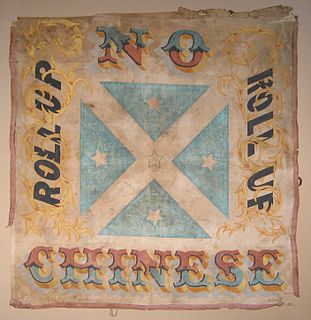
The Lambing Flat Riots (1860-1861) were a series of violent anti-Chinese demonstrations that took place in the Burrangong region, in New South Wales, Australia. They occurred on the goldfields at Spring Creek, Stoney Creek, Back Creek, Wombat, Blackguard Gully, Tipperary Gully, and Lambing Flat.

The Cariboo Gold Rush was a gold rush in the Colony of British Columbia, which earlier joined the Canadian province of British Columbia. The first gold discovery was made at Hills Bar in 1858, followed by more strikes in 1859 on the Horsefly River, and on Keithley Creek and Antler Creek in 1860. The actual rush didn’t begin until 1861, when these discoveries were widely publicized. By 1865, following the strikes along Williams Creek, the rush was in full swing.

Adelaide Lead is a district in Victoria, Australia, site of a former settlement, located on Old Avoca Road, south-west of Maryborough, west of the Paddy Ranges State Park, in the Shire of Central Goldfields. Located on the northern slopes of the Central Highlands, 225 metres above sea level, the area is naturally characterised by Box-Ironbark forest. Remnants of aboriginal settlement include rock wells beside the Possum Gully Road.
The Similkameen Gold Rush, also known as the Blackfoot Gold Rush, was a minor gold rush in the Similkameen Country of the Southern Interior of British Columbia, Canada, in 1860. The Similkameen Rush was one of a flurry of small rushes peripheral to the Fraser Canyon Gold Rush, which had drawn tens of thousands of prospectors to the new colony in 1858-1859, among the others being Rock Creek Gold Rush and Big Bend.

Eugowra is a town in the Central West region of New South Wales, Australia. The town is split between Forbes Shire and Cabonne Shire local government area, 341 kilometres (212 mi) west of the state capital, Sydney. At the 2016 census, Eugowra had a population of 779.
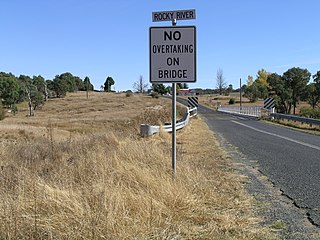
Rocky River is a locality in northern New South Wales, Australia near the town of Uralla on the Northern Tablelands plateau.
John George Gough, was one of the founders of the New South Wales Labour Party, initially the Labour Electoral League, the first political Labour movement in Australia. He was also one of Labour's five-member leadership group when the party first made its appearance in the New South Wales parliament in 1891. Representing Young, he was first elected in 1889 to the parliament's lower house as a member of the Protectionist Party, which produced Australia's first two prime ministers, Edmund Barton and Alfred Deakin. From 1891 to 1894 he represented Labour. Proud that his mother was Australian-born, he was a strong nationalist and republican. John Gough’s maternal grandmother was half-aboriginal. He is the only one of Labor’s founding fathers who has been found to have had aboriginal ancestry.

Kangaroo Flat is a suburb of the Greater City of Bendigo in Victoria, Australia. It is located 5 kilometres South-West of the Bendigo CBD. Kangaroo Flat is neighbours with Golden Square, Big Hill, Lockwood, Maiden Gully and Mandurang. Kangaroo Flat derived its name from the large "mobs" (groups) of Eastern Grey Kangaroos encountered around gold miners' campsites and in the vast bush (forest) landscapes around Bendigo.

Warrandyte State Park is a state park, located in Warrandyte, east of Melbourne, Victoria on the banks of the Yarra River and surroundings. The park comprises 586 hectares of remnant bushland in various locations throughout Warrandyte and Wonga Park around Pound Bend, Fourth Hill, Black Flat, Yarra Brae and various other locations in the area. It hosts many significant geographical, environmental, archaeological and historical sites, such as the site of the first gold discovery in Victoria in 1851 and preserves the sites of former gold mines and tunnels. It is a popular destination for school and community groups and is frequented by local bush walkers and hikers.
Various examples of violence have been attributed to racial factors during the recorded history of Australia since white settlement, and a level of intertribal rivalry and violence among Indigenous Australians pre-dates the arrival of white settlers from Britain in 1788.

During the Australian gold rushes, significant numbers of workers relocated to areas in which gold had been discovered. A number of gold finds occurred in Australia prior to 1851, but only the gold found from 1851 onwards created gold rushes. This is mainly because, prior to 1851, the colonial government of New South Wales had suppressed news of gold finds which it believed would reduce the workforce and destabilise the economy.
New South Wales experienced the first gold rush in Australia, a period generally accepted to lie between 1851 and 1880. This period in the history of New South Wales resulted in a rapid growth in the population and significant boost to the economy of the colony of New South Wales. The California Gold Rush three years prior signaled the impacts on society that gold fever would produce, both positive and negative. The New South Wales colonial government concealed the early discoveries, but various factors changed the policy.

The history of Chinese Australians provides a unique chapter in the history of Australia. The country has a long history of contact with China, some of which may even predate Captain Cook's arrival in the 18th century. Chinese people are now considered to be the oldest continuous immigrants to Australia outside of those from Great Britain. However it was during the Australian Gold Rushes that large numbers of Chinese made their way to Australia. This migration shaped and influenced Australian policy for over a hundred years. Despite these attitudes and restrictions many people with Chinese heritage have left their mark on Australian History.

Norton Goldfield is a heritage-listed former mine at Norton Road, near Nagoorin, Boyne Valley, Gladstone Region, Queensland, Australia. It was built from 1870s to 1941. It is also known as Milton Goldfield. It was added to the Queensland Heritage Register on 27 October 2006.

Station Creek Cemetery is a heritage-listed cemetery at Normanton Road, Croydon, Shire of Croydon, Queensland, Australia. It was opened c. 1899. It is also known as Golden Gate Cemetery. It was added to the Queensland Heritage Register on 25 October 2002.
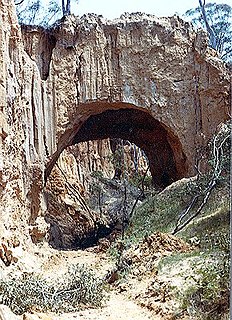
Golden Gully and Archway is a heritage-listed former mining and now pastoral property at Golden Gully, Hill End, Bathurst Region, New South Wales, Australia. It was built by European and Chinese gold miners. It was added to the New South Wales State Heritage Register on 2 April 1999.



